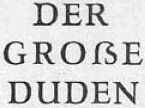Capital ẞ

Capital sharp s (ẞ) is the constructed "majuscule" of eszett (also called sharp s). Sharp s is unique among the letters of the Latin alphabet in that it had no traditional upper case. That is because it never occurs word-initially in German text, and German printing, which used blackletter, never used all-caps. In all-caps, traditional spelling rules required the replacement of ß with SS.[1][2][3] However, in 2010, the use of the capital ẞ became mandatory in official documentation in Germany for geographical names written in all-caps.[4][5]
History


There have been repeated attempts to introduce a majuscule ß. Such letterforms can be found in some old German books dating back to the late 19th century and some later signage and product design. One of the best known examples is the East German 1957 Duden.
Inclusion in Universal Character Set
A proposal by Andreas Stötzner to the Unicode Consortium for the inclusion of capital double s[6] in the Universal Character Set was rejected in 2004, on the basis that capital ß is a typographical issue and so is not suitable for character encoding. A reworked version of Stötzner's proposal was submitted on 25 April 2007 by DIN.[7] The proposal suggested the Unicode name LATIN CAPITAL LETTER SHARP S. The proposal was adopted and the character was added as Unicode character "ẞ" U+1E9E LATIN CAPITAL LETTER SHARP S[8] when Unicode 5.1 was released on 4 April 2008.
Support in computer operating systems
In Microsoft Windows, the Capital Sharp S has been included in system fonts such as Arial, Times New Roman, Courier New, Consolas, Georgia, Segoe UI, Tahoma and Verdana since Windows 7. On Mac OS X 10.6 and 10.7, only one Apple font includes it, Geneva Regular. Depending on the software, the fallback mechanism will likely show the font from a different typeface such as Arial. It has not yet been officially supported on Apple iOS.
Glyph designs
A number of designs have been proposed for the Versal-Eszett, all based on the origins of the lowercase ß as a ligature of a long s and a round z but with the principles applied to the design of uppercase, not lowercase, letters.
The most common is the design used on the cover of Signa magazine, which joins an ascender made from an inverted capital U to an ezh-like partial capital letter Z. Another similar design uses the ascender of a capital letter F instead of the inverted U ascender. A radically different design that still reflects the same typographic history consists of two capital letters S, joined by a short stroke at the top to form a ligature.
As of April 2008, typographers have yet to agree on a standard form for the letter capital ẞ, as they did in 1903 when an association of German printers and type foundries agreed on the "Sulzbacher Form" as standard for the lowercase ß.
References
- ↑ Institut für Deutsche Sprache. "Empfehlungen des Rats für deutsche Rechtschreibung, Teil 1: Regeln und Wörterverzeichnis" [Recommendations of the Council for German Orthography, Part 1: Rules and List of Words] (PDF) (in German). Archived from the original (PDF) on January 25, 2012. Retrieved 2012-02-09.
Steht der Buchstabe ß nicht zur Verfügung, so schreibt man ss.. . . Bei Schreibung mit Großbuchstaben schreibt man SS, zum Beispiel: Straße – STRASSE
- ↑ Siever, Jörn (28 June 2002). "1.1.3 Sonderbuchstabe B". Standiger Ausschuss fur geographische Namen (StAGN) Empfehlungen und Hinweise fur die Schreibweise geographischer Namen fur Herausgeber von Landkarten und anderen Veroffentlichungen [Toponymic Guidelines for Map Editors and Other Editors. Federal Republic of Germany - Fourth Edition] (PDF). Eighth United Nations Conference on the Standardization of Geographical Names (4. Ausgabe [Fourth edition] ed.). Frankfurt, Berlin. Archived from the original (PDF) on 2015-12-26.
- ↑ "2.3 Besonderheiten bei [s]". Regeln und Wörterverzeichnis Entsprechend den Empfehlungen des Rats für deutsche Rechtschreibung [Rules and Glossary in accordance with the Recommendations of the Council for German Orthography] (PDF) (Report) (in German). Teil I Regeln (Überarbeitete Fassung des amtlichen Regelwerks 2004 [Revised version of the official 2004 Guideline] ed.). Mannheim: Rat für deutsche Rechtschreibung. 2006. Archived from the original (PDF) on February 17, 2016.
- ↑ (German) Empfehlungen und Hinweise für die Schreibweise geographischer Namen, 5. Ausgabe 2010
- ↑ Siever, Jörn (2010). "1.1.3 Sonderbuchstabe ß ß". Standiger Ausschuss fur geographische Namen (StAGN) Empfehlungen und Hinweise für die Schreibweise geographischer Namen für Herausgeber von Kartenwerken und anderen Veröffentlichungen für den internationalen Gebrauch [Toponymic Guidelines for map and other editors for international use] (PDF) (Report) (5. überarbeitete Ausgabe [Fifth revised] ed.). Frankfurt: Geschäftsstelle des StAGN im Bundesamt für Kartographie und Geodäsie. Archived from the original (PDF) on 2015-12-27.
- ↑ "Proposal to encode Latin Capital Letter Double S (rejected)" (PDF). Retrieved 2014-01-30.
- ↑ "DIN_29.1_SCHARF_S_1.3_E" (PDF). Retrieved 2014-01-30.
- ↑ "Unicode chart" (PDF). Retrieved 2014-01-30.
Sources
- Das große Eszett. In: Signa, Heft Nr. 9. Edition Waechterpappel, Grimma 2006, ISBN 3-933629-17-9. (in German)
External links
| Wikimedia Commons has media related to Capital sharp s. |
- Andreas Stötzner: Capital Double S. Proposal to the Unicode Consortium (pdf) (in English)
- The „Versal-Eszett“ in the Typowiki (in German)
- Discussion of letterforms for capital ß in typeFORUM (in German)